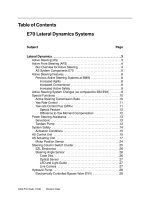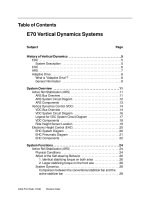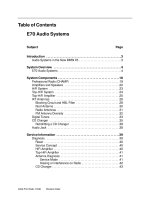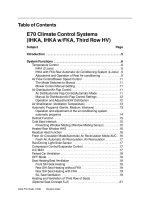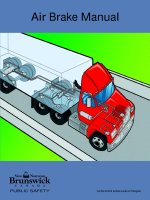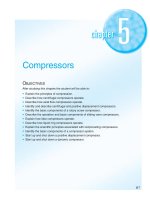Antilock Brake Systems
Bạn đang xem bản rút gọn của tài liệu. Xem và tải ngay bản đầy đủ của tài liệu tại đây (31.86 KB, 2 trang )
Antilock Brake Systems
Antilock Braking Systems (ABS) is a form of electronic braking which was invented to
help a driver control a vehicle under heavy braking by preventing the wheels from
locking up.
How they work
Braking systems take the force applied to the foot pedal by the driver and transfer it via
a mechanical system to the brakes on the wheel. The mechanism works by increasing
the input force via a servo to the master cylinder, which converts the force into the
pressure applied by brakes. The master cylinder has two pressure chambers both of
which are responsible for the braking pressure on two of the wheels and this is to
provide an extra level of safety should there be a failure.
During this process there is a chance that the wheels stop rotating before the car
comes to a halt. This process is known as ‘locking up’ and means that the braking force
on the wheel is not being transferred efficiently to stop the vehicle due to the fact that
the tyre is sliding upon the road.
This leads to a longer stopping distance than if the wheel had not locked because there
is reduced grip between the car and the road, which in turn leads to an increased
chance of losing control of the vehicle and skidding.
On vehicles without ABS the best method to regain control of the vehicle is to ‘pump’
the brakes by taking your foot off the pedal and reapplying it. This allows the tyres to
regain traction upon the road, rather than skid over the surface of it.
ABS works in a similar but much more effective manner. Electric sensors monitor the
speed of the wheel as it rotates and detect if it is about to lock up under braking. When
this happens the brakes are automatically released and then rapidly reapplied. This
process occurs several times to prevent a skid and to ensure that a vehicle can be
steered by the driver to avoid a collision.
The advantages of ABS
Although the ABS will not decrease a vehicle’s stopping distance compared to an
identical vehicle without ABS, it ensures that the shortest distance in which a vehicle
can be brought to rest is achieved. It is particularly effective in doing this on surfaces
which are wet or icy upon which a vehicle is much more likely to skid.
The main benefit of ABS is the control that a driver has over the vehicle’s steering. In
an emergency the driver of a vehicle equipped with ABS will have a better chance of
steering around the obstacle due to the reduced risk of skidding.
The Royal Society for the Prevention of Accidents
RoSPA House, Edgbaston Park, 353 Bristol Road, Birmingham B5 7ST.
Telephone: 0121 248 2000 Fax: 0121 248 2001 www.rospa.co.uk Registered Charity No: 207823
Antilock Brake Systems and your vehicle
When buying or driving a new car, find out if it has ABS, as this will greatly effect what
you should be doing in an emergency situation. Consult the vehicle’s handbook, which
will tell you what active safety features your vehicle has and also what warning lights
will be displayed should there be a failure.
When hiring a car or taking out a new company pool car, ask what safety features the
car has and whether it has ABS.
What to do in an emergency situation
If your vehicle has ABS, in an emergency situation firmly press the brake pedal and
keep your foot hard on the brakes.
It is likely that you will feel feedback from the ABS on the brake pedal in the form of
vibration or pulsation. This can be an unfamiliar and maybe uncomfortable experience
but it is proof that the ABS is working and the correct course of action is to keep your
foot hard on the brakes.
As previously stated, the main advantage with ABS is the increased control over the
steering. In situations such as when a small obstacle appears in the road or attempting
to remain in the same lane when braking – this can be invaluable.
However, care should always be taken to avoid any rash steering manoeuvres that
would increase the severity of the collision.
Although ABS ensures that the minimum stopping distance is achieved, it is still
important to drive at a safe speed for the conditions and leave a gap of at least 2
seconds between yourself and the vehicle in front in order to reduce the chances of
needing to make use of the ABS.
The Royal Society for the Prevention of Accidents
RoSPA House, Edgbaston Park, 353 Bristol Road, Birmingham B5 7ST.
Telephone: 0121 248 2000 Fax: 0121 248 2001 www.rospa.co.uk Registered Charity No: 207823



